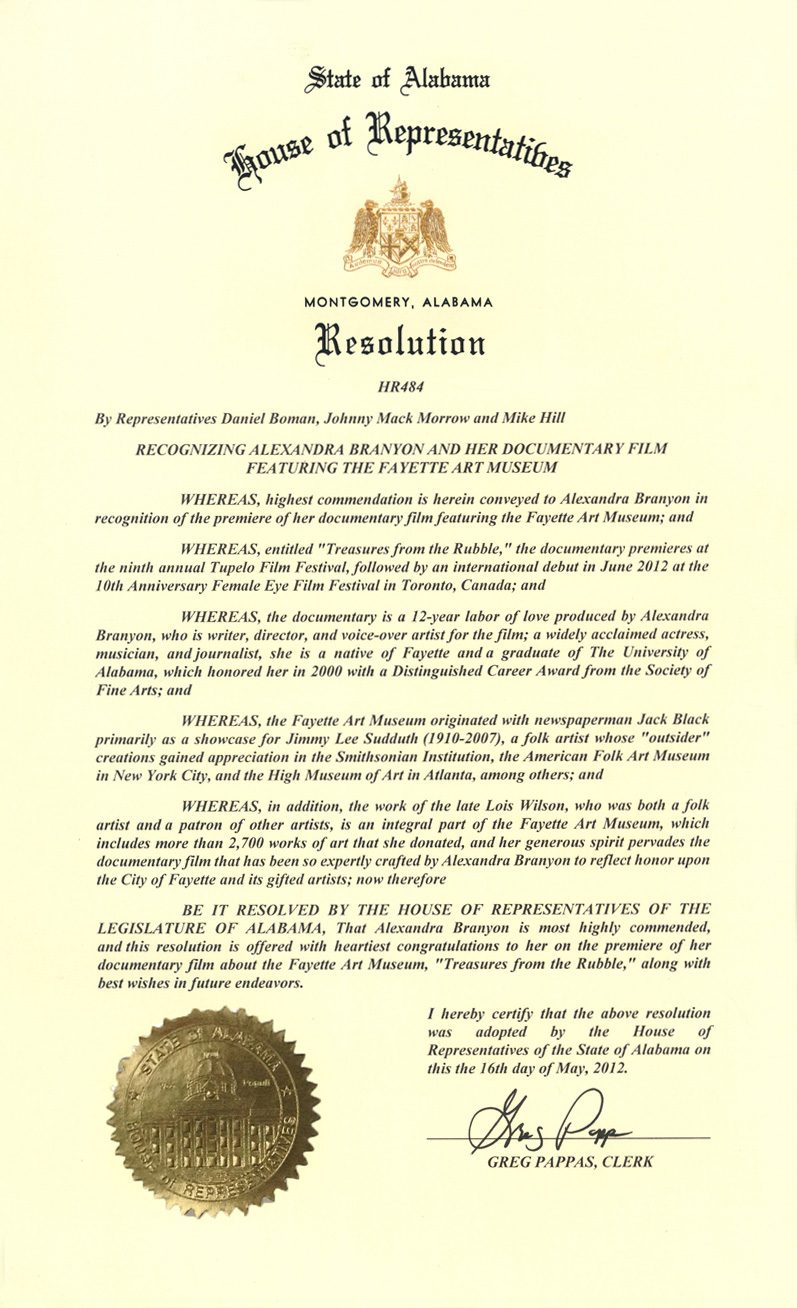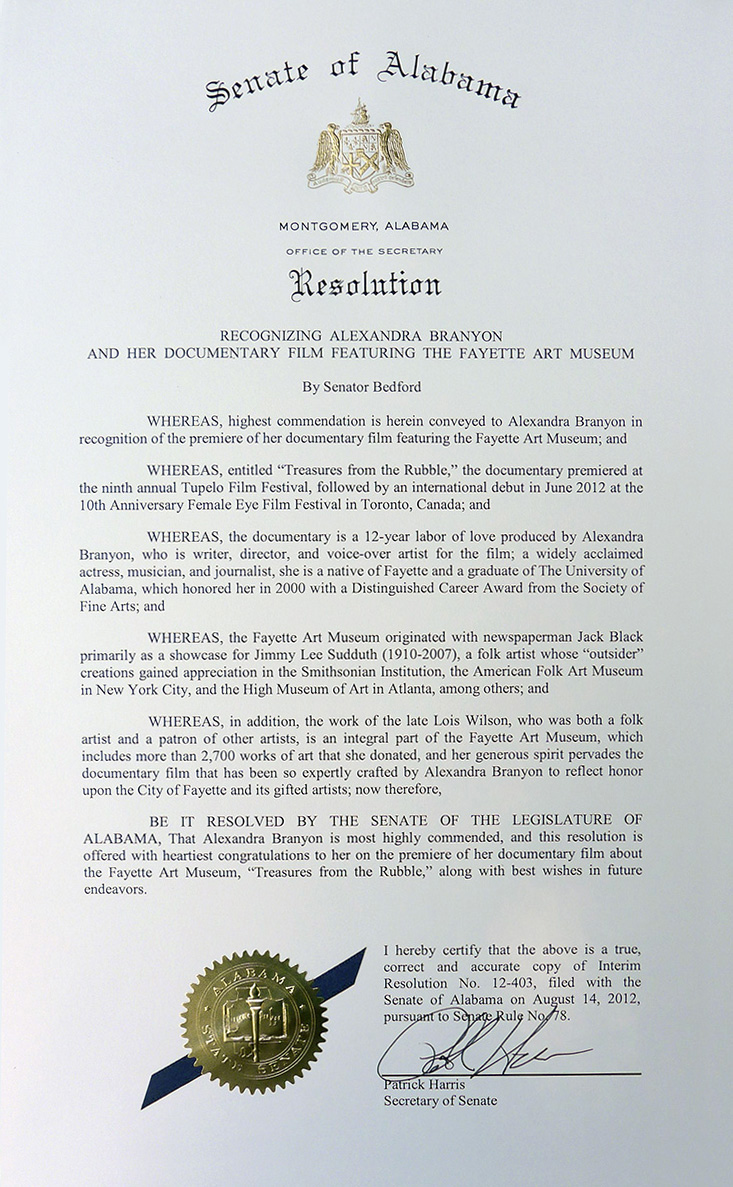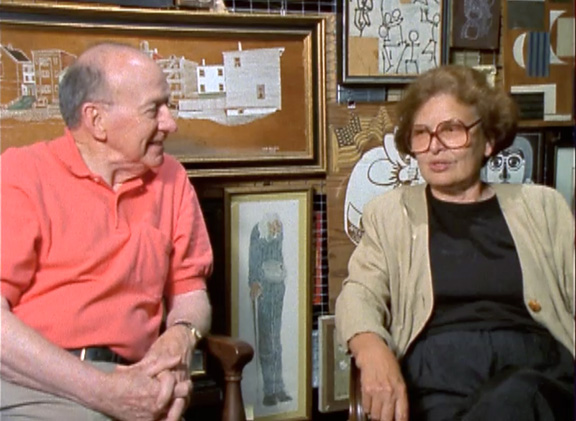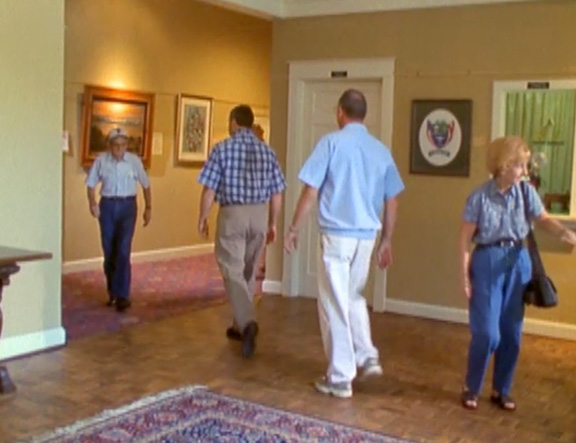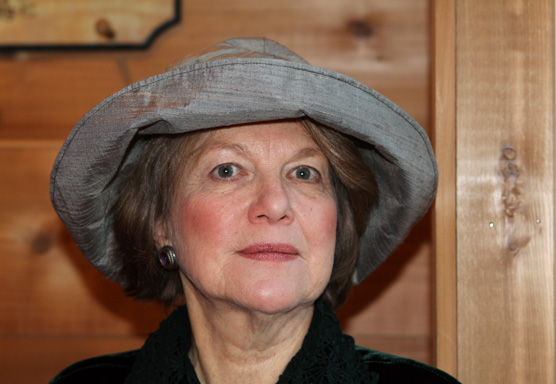Author Archives: Alexandra
House of Representatives Resolution
Alabama Senate Resolution
Fayette to Host Film’s State Premiere
Story of woman’s lifelong art collection led to creation of Fayette Art Museum
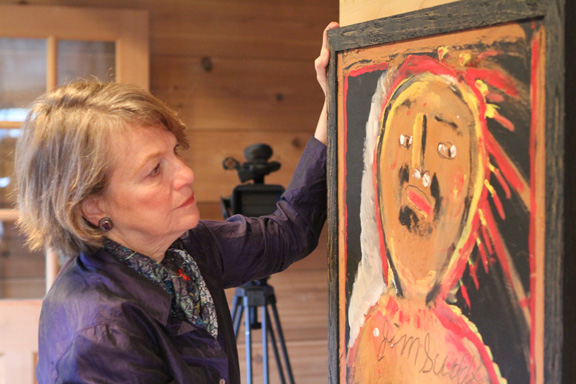
Alexandra Branyon, writer and director of the documentary “Treasures from the Rubble,” about the creation of the Fayette Art Museum, looks at one of the collection’s paintings by Jimmy Lee Sudduth.The film will be shown Aug. 24 in the Fayette Civic Center, which houses the museum. (Submitted photo)
By Mark Hughes Cobb
Staff Writer
Published: Sunday, August 18, 2012
As an actress, musician and journalist, Fayette native Alexandra Branyon has worked in and seen quite a bit of the world, but she found the story for her first film back home.
“Treasures from the Rubble,” which has its state premiere Aug. 24, became a 12-year-long labor of love for Branyon. The film tells the world about the late artist Lois Wilson, whose desire to keep her lifelong assemblage of created and collected art safe led Jack Black, editor and publisher of the Fayette County Broadcaster, to create the Fayette Art Museum.
Wilson studied art in Europe and New England, living and working most of her life in and around New York, but never gained much renown, and certainly no wealth. So she turned to Black, who was charged by Wilson’s drive to create art from found objects and by the vivid imagery she evoked. Wilson ultimately donated 2,600 pieces, some of them her own assemblages, others pieces she’d bartered from fellow artists.
Black and Wilson’s collective efforts grew into a home for other outsider or primitive artists, such as Sybil Gibson, B.F. Perkins, Fred Webster and Jimmy Lee Sudduth, whose worldwide fame spread outward from that little town of 5,000 people.
In 1980, Wilson died poor and still unsung, although assured her art had found a home. Black helped carry the museum’s story forward, winning acclaim from National Geographic and others, but Branyon felt their saga just hadn’t been captured the way she saw it: on film.
“Treasures from the Rubble,” which she wrote, directed and produced, premiered in May at the Ninth Tupelo Film Festival, then went international in June with Toronto’s Female Eye Film Festival. On Aug. 24, the film will finally be shown at home, in the Fayette Civic Center that houses the renowned museum.
“Jack Black was a quiet force who brought Lois Wilson home, and that was really the beginning of the museum,” Branyon said. “And now Jack Black is bringing me home.”
Although she lives in Amagansett, N.Y., Branyon returned to her alma mater, the University of Alabama, around 2000 to receive a Distinguished Career Award from the Society for the Fine Arts. Over her life, she’s performed musical comedy for Joseph Papp’s Public Theater, played piano with studio bands in New York City and with a theater orchestra in Honolulu, and taught playwriting at the New School for Social Research, among other accomplishments.
Black, who had been a mentor to Branyon when she edited the Fayette County High School newspaper, gave the introduction for Branyon at the Society for the Fine Arts banquet. Their talk afterward spurred the movie forward. Though she joined forces with editor Maria Maciak and composer Margaret Kitchings, who also played a ghostly Wilson-like presence in some memory scenes, Branyon had to assemble it as she could, learning about filmmaking along the way.
It’s especially poignant to again see and hear some of the film’s main subjects, including Black, his wife, Margaret, and Sudduth, all of whom have died n in recent years, said Anne Perry-Uhlman, director of the museum.
“I was overwhelmed, I thought it was really good,” said Perry-Uhlman, who was among a van-load of Fayette residents who drove to Tupelo for the premiere. “It was nice to hear Mr. Black and Ms. Margaret talk again, to see Jimmy Lee, to hear it all like it was still going on.”
The Tupelo festival was an “unbelievable event,” Branyon said. Being accepted was one reason. The second was that because the filmmaker whose work preceded hers failed to show for a question-and-answer period, the festival emcee asked Branyon, at the last minute, to give a time-filling talk.
“Southerners are chatty, thank God,” she said, laughing. “So for 15 minutes I did an impromptu speech.”
Afterward, during what was to be Q&A for “Treasures,” her brother came out with flowers, then Alabama state Rep. Johnny Mack Morrow brought out an official resolution honoring the film.
“I’ve never been so shocked in my life,” she said. Branyon witnessed folks crying after seeing their now-deceased friends again. “I got the sweetest email later saying, ‘I have been getting the feeling Fayette was disappearing; now this makes us feel alive.’ ”
In Toronto, she scored a large crowd because the filmmaker whose work preceded hers was locally popular.
“I had a big audience in Mississippi, but I just anticipated six people in the audience in Toronto; that’s not my neck of the woods,” she said. Interestingly, “Treasures from the Rubble” got nominated for best documentary, while the local hero’s work did not. Although she feared this Southern story wouldn’t play outside the region, the audience laughed in the right parts, she said, and swarmed her afterward, quoting back lines from the film to her.
The party for the Alabama premiere will begin with hors d’ouevres at 6 p.m. Aug. 24 in the Fayette Civic Center, with a presentation at 7, and the film beginning at 7:30. It’ll be a red-carpet premiere, Perry-Uhlman said, in the auditorium, which seats 365.
“We’re going to open a new exhibit with Mayor Guthrie Smith memorabilia, pieces of his that were donated to the museum, and we’ll be open for tours,” she said.
Tickets are $10, and at press time, about half the seats were already sold. To reserve a place, call 205-932-8727 no later than Wednesday.
Download Press Kit
Fayette Times-Record
Tuscaloosa News
“Documentary Sings Praises of Fayette Art Museum”

Alexandra Branyon, writer, director and voice-over artist for the documentary “Treasures from the Rubble,” about the creation of the Fayette Art Museum, looks at one of the collection’s many paintings by Jimmy Lee Sudduth. (Submitted photo)
By Mark Hughes Cobb
Staff Writer
Published: Sunday, May 13, 2012
In the folk art world, the late Jimmy Lee Sudduth stands tall, a sweet man of enormous energy and spirit, prolific in raw paintings of mud on wood or cardboard. Patrons of the Kentuck Festival of the Arts remember his many years lingering in the shade of a pine, playing harmonica and chatting with patrons who snapped up every piece he’d paint.
But it wasn’t so many years ago that Sudduth painted purely for the creation of it. He probably never suspected he’d someday be collected in the Smithsonian Institution, the American Folk Art Museum in New York, the High Museum of Art in Atlanta and many others. It took another avid artist born in the area, Lois Wilson, and the drive of newspaperman Jack Black to help light the fuse of the folk art boom with the Fayette Art Museum.
Folk art lovers know about Black, Wilson, Sudduth, Sybil Gibson, B.F. Perkins, Fred Webster and others in the more than 3,700 pieces of contemporary, fine and folk art collected there, but hometown native Alexandra Branyon hopes to spread the story even wider with her documentary film “Treasures from the Rubble.”
A 12-year labor of love, “Treasures from the Rubble” premieres Thursday at the ninth annual Tupelo Film Festival, with an international premiere following in June at the 10th anniversary Female Eye Film Festival in Toronto, Canada.
It began in 2000, when Branyon came back to her alma mater to receive a Distinguished Career Award from the Society for the Fine Arts at the University of Alabama. The Fayette native who now lives in Amagansett, N.Y., has worked as an actress, musician and journalist, doing summer stock, dinner theater and musical comedy for Joseph Papp’s Public Theater. She’s studied composition at Juilliard, voice with a Metropolitan Opera tenor, and acting with Lee Strasberg’s private class; played piano with a theater orchestra in Honolulu and studio bands in New York; and has taught playwriting at the New School for Social Research in New York. All her skills came together in “Treasures from the Rubble,” which she wrote, directed and produced.
Black had been publisher and editor of the Fayette County Broadcaster when Branyon edited the Fayette County High School newspaper. Black became a mentor to the young woman. He introduced her at the Society for the Fine Arts banquet, and they talked after.
“For the last 35 years, he’d been creating an art museum in Fayette from the work of this fascinating woman, Lois Wilson,” Branyon said. Like many folk artists, Wilson was born poor, and worked with whatever materials she could find. Born in 1905, she did go on to study formally, but kept the same primal drive. Wilson’s desire to keep in one place her art, and those pieces she’d collected, led Black to create the museum. She donated more than 2,700 works of art to the cause.
“I said to Jack Black, ‘I’ve never done a documentary before, but guess what? I’m going to do it,’ ” Branyon said.
She intended the film as a tribute to her hometown, and to people like Black and his wife Margaret, who was Branyon’s high school English teacher.
“It’s a real love letter to the South,” she said. “I’ve shown it to some people up here, and down to the last one, they say ‘I never wanted to go to Alabama before, but now I do.’ ”
Principal filming took place that year, but having no big financial backing, Branyon wound up doing much of the work herself.
“I felt I had to do everything,” she said. “That’s the advantage of not having money. I was forced to do more. And the more you do, the more you have control over your own vision.”
She did take along longtime friend and collaborator Margaret Kitchings, who composed music and wound up playing an inspired part. Black took them through every piece in the museum, and they interviewed him and others. Sudduth, who died in 2007, was captured on film not just talking, but performing.
“He did a real star turn,” Branyon said. “I made him a very large presence, as the most famous artist to come from Fayette.”
Wilson had prompted Black to give Sudduth his first one-man show, which got everything started for him.
“(She) wasn’t just an artist, she was a patron of the arts. She was born poor, lived poor and died poor as I say in the film,” she said. “But her philosophy was that one of the great lessons of poverty is to recognize the essential.”
The director wanted her at the heart of the film, but because the artist had died in 1980, and was no fan of being photographed, there wasn’t footage to use. Branyon had an inspiration.
“Lois Wilson was what she called a spiritualist: She believed you could talk to the dead. A lot of her ideas came from what she called spirit artists,” Branyon said. “I wanted her philosophy and her way with words (as captured in letters), so I wondered ‘How can I get this in there?’ ”
She looked over at Kitchings. They went out and bought a simple dress, a big plain hat to hide the face, and the composer, who had studied acting earlier in life, stood in as the Lois Wilson figure, drifting through black and white scenes while Branyon read voice over.
“That pulled the whole film together,” Branyon said. “She looks almost like a little Charlie Chaplin figure.”
Later, Kitchings scored scenes for emotional content, working closely with Branyon.
“I write mostly when I’m out in nature,” Kitchings said. “I’m not a very technical musician. But I’m a great walker, and I get these melodies that come into my mind.”
She’d put the melodies down on piano, then consult with the director on what worked. Back in Amagansett, they put together a small band and spent about five days recording, with piano, flute and other instruments. The Dixieland-style closing track includes John Bucher, who plays horn in Woody Allen’s band.
Post production ate up the years.
“Sound effects alone took almost a year, to add drama, in some cases to add humor,” she said, indicating a debt to the fastidious detail-oriented work of Alfred Hitchcock. “We added the sound of footsteps to show Jack was a living presence, and the absence of footsteps when Lois Wilson’s spirit walks across the room.”
Although she’d have liked to have shown it first in Fayette, film festivals are picky; if it had shown anywhere publicly, it couldn’t be labeled a premiere.
“It’s very difficult to get in film festivals. The competition is awful, and it seems like you have to know someone,” she said. “But I knew no one in Tupelo and no one in Toronto.”
She was very pleased that Tupelo, not a long drive from Fayette, picked it up. The Canada acceptance surprised her.
“I knew the South would love this film, because it’s a love letter to the South,” she said. “I hadn’t even had in mind that other countries would like it.”
Branyon hopes to show the documentary at the Fayette Art Museum in August or September, and continue to work to get it seen, even as she works on other projects.
“After those three premieres, what I want to do is start looking at the education market, get the film out to museums and universities. This is a story people not only need to know, but will I think enjoy.”
Setting Up a Controlled Environment to Solve a Key Problem of Character Development
The focus of Treasures from the Rubble is on the artist Lois Wilson, which led to the problem of making Wilson a vivid character despite the fact that she is not in the filmed material and was an elusive personality during her life. A key to solving this challenge was in getting Jack Black (the curator) and Wilson’s niece to talk about Wilson very personally and pointedly.
Lois Wilson wrote volumes of fascinating profound letters, many of them to Jack Black. I went through each letter over and over until I found the story that I wanted to tell. I marked every important point in the letters with a post-it.
When we went to Alabama to shoot the film, I set up their interview as merely a conversation between the two of them, with no interviewer in sight. However I was in the background steering the conversation in the direction I knew was needed for the story.
Before the camera rolled, I would simply say to them that I was going to read an excerpt from a letter and would like them to say anything that came into their minds in regard to it. We never did a take two as the spontaneity was infectious and their reactions felt fresh although the interview was carefully orchestrated.
Turning an Uncontrolled Environment into an Advantage
One unexpected challenge in the production phase of making “Treasures from the Rubble” was that although we had arranged to shoot the film at the museum in advance there was a mix-up and the museum had also scheduled rehearsals for a large full-blown musical.
Fortunately the director of the musical understood our plight and was cooperative in that the singing, dancing, clapping, stomping, shouting would stop every time we asked for a moment of quiet, which we did judiciously in order not to antagonize anyone. We tried to cooperate with them also by holding off a scene until they said it was ok with them for us to continue.
On the day we were scheduled to film in the museum’s lobby, in addition to the musical in the adjoining auditorium, it turned out to be voting day, and streams of people were coming through the lobby to vote. I decided to turn a negative into a positive by asking some of the voters to walk a little slower, stop and look at a painting. They became my impromptu extras. My “museum visitors” were multi-tasking.
Director Statement
“Treasures From the Rubble” began in 2000 as an intriguing challenge for a theater artist to move into film. It has turned out to be something wholly unexpected: a deep plunge into memory.
I had returned to my alma mater, the University of Alabama at Tuscaloosa, to accept a distinguished career award from the university’s Society for the Fine Arts. There Jack Black, a man who had been editor of my hometown paper when I was in high school, told me the story of Lois Wilson, an eccentric artist from our home town of Fayette, her career in New York, and her dream of preserving her work and her collection of other artists’ work in a safe place away from approaching bulldozers and a threatening landlord. Black carried Wilson’s dream to fruition with the establishment of the Fayette Art Museum, now a thriving cultural center in the region.
I found that I identified with Wilson. Both artists intent on leaving the small town behind for the wider world of New York. Both finding in Black a man who would guide us back home not just as wandering natives but also as artists.
The making of the film drew me back to Fayette, which produced the town’s most famous artist, Jimmy Lee Sudduth, whose appearance in the film was no less than a star turn as he talked about his life and techniques and played his harmonica. Internationally known as “the mud artist”, Sudduth got most of his mud up and down the railroad track. My childhood memory of riding on the train over those tracks with the whistle blowing and the conductor waving brought the sound of the train into the film as a subliminal representation of the story’s journey.
When Sudduth spoke about being able to find “36 different colors of mud, ranging from blue, white, or red, or brown”, I remembered as a child walking through the woods with my brother, finding small rocks and hitting them against each other until they opened, spilling out their vivid dusts of blue, white, red, and brown. We would draw faces, letters and symbols with that magical dust on a big stone before we got onto a small barge from which my brother would use a long wooden stick to move us out into the lake where we would fish with a cane pole for brim and bass till dusk was announced by the slow ethereal call of bob-bob-whites echoing through the hills of trees covered in bright green kudzu vines.
In keeping with my memory of a less complicated and unhurried time, “Treasures from the Rubble” was shot with one camera and minimal lighting — black and white footage calls up the past and color footage brings us forward to the present. The camera explores each painting at random as simply and innocently as Lois Wilson picking up scrap tin from her father’s blacksmith shop and snitching the black shoe polish out of the pantry to make her first paintings.



